Vessel Box, Vessel--Cup, Wesley--Cup and Wesley Bob or Advent Images. (Lucy Green)
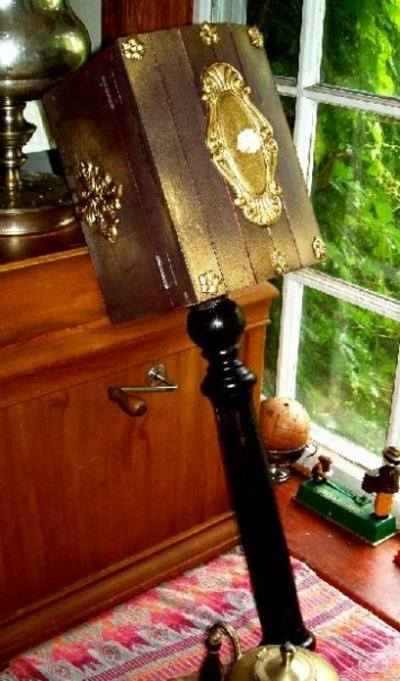
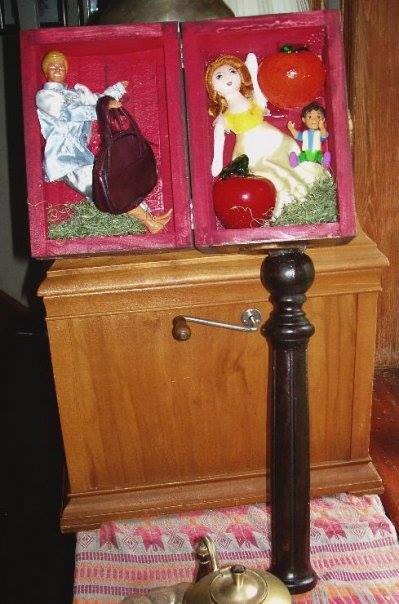
| The Wassail Box- Vessel Box, Vessel--Cup, Wesley--Cup and Wesley Bob or Advent Images. (Lucy Green) For the Main Menu Click Here
  |
|
Source: --Be
sure that people have started the season Often associated with Advent, this
ritual consists of the appearance of a single individual carrying a vessel box.
The celebrant comes to the door and asks if those within wish to see inside the
box. The box is covered with cloth and mounted on a post. When the donation is
received carols are sung, the cloth is lifted. The box is opened exposing a
collection of objects including dolls representing the holy family, apples,
oranges, paper decorations, moss and greens. Woe to those who do not treat the
vessel box wassailers with respect!
|
"Wassail Boxes" are still carried round, generally by girls and in the month of November only, in Scarborough and its neighbourhood, but the number has very greatly lessened of late years, and the boxes now do not always contain a doll, but sometimes merely a few sprays of holly and an orange or apple. In one box carried round two winters ago, there was a single doll with an indistinct black object at one side, of which the two tiny boys carrying the box said "Please, mum, it's the devil!" The name "vessel cup" is not used in this neighbourhood…..(photo of box deleted) The box photographed….was obtained for me from the village of Wheatcroft, by S----A------, who is a Roman Catholic. The dolls in it have been carried round for twenty--five years. The box measures 11 1/4 in. x 7 1/2 in. by 3 in. deep. It has a lid, but this is not always the case, though the contents of a box are always covered. The box contains besides the two dolls (the large of which is dressed in red), paper flowers, a lemon, holly and mistletoe, a purse, and an artificial orange and an artificial apple, both the artificial fruits containing sweets. If all the fruits are real, it is necessary to put in a bag of sweets. The purse should have a hole in it. The children carrying a box never knock or ring, but open each house door and begin to sing,"God rest you, merry gentlemen."If no notice is taken, they sing the piece over again, until someone goes to speak to them. They then ask if anyone would like to see the "wassail box." if no one cares to look at it, they go quietly away. They never uncover the box without first asking,"Would you like to see the wassail box?" S.A.'s mother says that the dolls represent the Virgin and Child, and that the box should be made of "parch--board" and lined with moss and ivy. In the Mirfield district of the West Riding the children used to go wassailing with two dolls etc. in a clothes basket covered over with a white cloth. At Pontefract the dolls were carried in a box. The following version of the ballad sung was written down for me exactly as remembered by S. A. In some parts additional lines, beginning "Call up the butler of this house," were also sung.
"God rest you all merry Gentlemen, Let nothing your desire (sic); Remember Christ our Saviour Was born on Christmas day, To save poor souls from Satan's power Long time have gone astray. A star appeared in Bethlehem That glorious Christmas morn, To spread the joyful tidings That a Saviour had been born. And the shepherds tending to their flocks Gazed on the heavenly sight, And guided by the star so bright They found Him who is Christ the Lord, All meanly wrapped in swaddling bands And in a manger laid. Glad tidings of great joy I bring To you and all mankind.
"God bless the master of this house, Likewise the mistress too, And all your pretty children Around your table go. For it is the time of year When we travel far nad near; So God bless you and send you A Happy New Year. We have a little purse, It is made of leather skin, We want a little of your money To line it well within. Our boots are very old, And our clothes are very thin; We're tired out with wandering around, And if we cannot sing, If you only spare a copper To line the puirse within.
So God prosper you and I wish you a Merry Christmas and a Happy New Year."
Near Normonton, where the custom still continues, different verses are sung, of which the following are a specimen:--
"Here we come a--wessailing (sic) | among the leaves so green. And here we come a--wandering| so fair to be seen. Love and joy come to you, And to you your wassail too, And God send you a Happy New Year, a New Year! And God send you a Happy New Year! "We are not daily beggars| that beg from door to door, But we are neighbour's children | that you have seen before. Love and joy come to you (etc')
"I have a little purse | lined with stretching leather skin, And I want a little of your money | to link it well within. Love and joy come come to you"(etc') --E. Wright.
--Wright, E. "A Yorkshire Wassail Box", In: Folklore, Vol. 17, No. 3, September 30, 1906, pp. 349--351.
Vessel Cup Yorkshire 1911 "What is popularly known as wassailing was the custom of trimming with ribbons and sprigs of rosemary a bowl which was carried round the streets by young girls singing carols at Christmas and the New Year. This ancient custom still survives here and there, especially in Yorkshire, where the bowl is known as `the vessel cup,' and is made of holly and evergreens, inside which are placed one or two dolls trimmed with ribbons. The cup is borne on a stick by children who go from house to house singing Christmas carols. In Devonshire and elsewhere it was the custom to wassail the orchards on Christmas and New Year's eve. Pitchers of ale or cider were poured over the roots of the trees to the accompaniment of a rhyming toast to their healths" --Encyclopedia Britannica, Eleventh Edition, vol. 28, 1910--1911, p. 361. Christmas Vase 1912 In Yorkshire only one image was carried about. At Gilmorton, Leicestershire, a friend of the present writer remembers that the children used to carry round what they called a "Christmas Vase," an open box without lid in which lay three dolls side by side, with oranges and sprigs of evergreen. Some people regarded these as images of the Virgin the Christ Child and Joseph.
--Miles, Clement, S., Christmas in Ritual and Tradition, 1912, p.139.
Vessel Box,Christmas Eve at Bank House, Cawthorne near Barnsley, 1924.
“Little children, too arrived carrying dressed--up dolls in wooden boxes:
God bless the Master of this house, God bless the mistress too And all the little children that round the table grew.”
--Stirling, A.M.W. Life’s Little Day, London, 1924, p.112.
Advent Images, Yorkshire and Elsewhere: Ralph Duncan 1925
(see also music section) 1. The week before Christmas, in Yorkshire, women go house to house carrying "two dolls, dressed the one to represent the Saviour, and the other the Virgin Mary." 2. These are called Advent Images and those going about with them sing a carol which is derived from “the Seven Good Joys” and “God Rest You Merry Gentlemen.” 3. After singing, a half-penny donation is asked. 4. "It was the height of ill luck to deny." 5. It was bad fortune for a household not to be visited before Christmas Eve. 6. Duncan notes that this is the origin of the saying: “As unhappy as the man who has seen no Advent Images."
--Duncan, Ralph, Second Book of Christmas Carols, 1925, p. 62 Advent Images and Lucy Green, J.E. Thomas et. al. 1926 1. The tune used for “Lucy Green” is derived from the one in Bramley and Stainer. 2. Celebrants corrupted the first verse in the Camborne Carol party. Mr. Bennetts recalled that they took a small child dressed in evergreen branches and called it “Lucy Green.” 3. It is believed that the “Lucy Green” was a substitute for the wassail bowl which was said to be the older custom. 4. Another similar custom cited is the “Turkey Claw Chori”. The person collecting the money would carry a turkey claw as a badge of office. Mr. Miners thought it was derived from the insignia of a “privileged chori” of the past. 5. Sources cited: J.E. T. Cf. English Country Songs, p. 14.--L.E.B. For Lancashire and Yorkshire versions of this "leaves so green" wassail song, see Journal. Vol. V. pp. 210--11. 6. It is thought that the small child dressed in evergreen from the Camborne Carol Party is “confused.” It was originally the “vessel-cup” Christmas custom. That is a box with two dolls inside dressed as the Virgin and child. 7. Thistleton Dyer, discussing Yorkshire customs (Thistleton Dyer, British Popular Customs, p. 464) noted that only the image of the Saviour was carried in a box with evergreens and seasonal flowers included. “The household visited by the party were allowed to take from these decorations a leaf or flower, which was carefully preserved as a sovereign remedy for toothache.” Dr. Dunstan prints one of these "Advent Images" carols (see his Second Book of Christmas Carols, 1925,) 8. The tune used is recorded as "Seven Joys of Mary," sung to the tune of "God rest you merry.” Dyer also notes: “it was deemed most unlucky to refuse a contribution, and also an omen of ill if a household was not visited by the Advent Images before Christmas Eve at the latest.” 9. Dr. Dunstan also published a West Riding "Vessel--Cup" or Wassail Song. Its chorus begins “Pier! Tier! Wessel! And a jolly wessel,” “as now generally sung by children decked and carrying evergreens and sometimes having blackened faces.”--A.G.G.
--Thomas, J.E., Et. Al., "Cornish Carols", In: Journal of the Folk--Song Society, Vol. 8, No. 33, 1929, pp.111--124, (p. 120.)
The Vessel Coop Grinton, Richmond 1927--1955
Here we come a wassailing------
I neither come to your house Not to beg nor borrow, But I come to your house To drive away all sorrow.
God bless the master of this house, And the mistress also, And the little children That around the table go (or grow)
With your pockets full of money, And your barrels full of beer, I wish you a merry Christmas, And a happy New Year----
God bless you and send you a happy New Year.
-- Grinton, Richmond-- Mrs. J. T. Kendall, Sung at Christmast time,----Singing thought to ward off bad luck----Little wooden box decorated with holly and ivy, and in little nest a little doll dressed like baby---- Sometimes two (Miss Mangle) (from 00635 Scatterin Day-- Border town, and Reeth-- Roll apples about for children. Longest day-- games, feast-- Gunerside, --had ginger bread and milk.)
--Library of Congess James Madison Carpenter Collection, AFC 1972/001, American Folklife Center Archive, Used by Permission, Library of Congress, Washington, D.C., 00635. (Dates: 1927--1955).
Robinson Vessel Coop, Preston Under Scar 1927--1955
God rest you all, merry gentlemen Let nothing you dismay Remember Christ Our Savior Was born on Christmas day.
To save our souls from Satan strong, Long time had gone astray, It brings tidings of comfort and joy.
God bless the master of this house, Likewise the mistress so, And all the little children That round your table go. And all your kith and kindred That travel far and near, And I wish you a merry Christmas And a happy New Year.
--Vessel Coop, Mrs. George Robinson, Preston Under Scar---- Learned from older villagers. At Christmas time, A little doll in a box, little holly round it— James Madison Carpenter Collection, AFC 1972/001, American Folklife Center Archive, Used by Permission, Library of Congress, Washington, D.C., 02030. (Dates: 1927--1955).
Christmas Dolls, Bellerby 1927--1955
God bless the master of this house, And the mistress also And all the pretty children That round your table go.
God bless your kith and kindred, Your friends both far and near, Wishing you a merry Christmas And a happy new year.
We are not daily beggars That beg from door to door, We are your neighbors children Whom you have seen before.
Pocket full o money And a cellar full o beer.
--Christmas Dolls, Mrs. Thistlethwaite (?)), Bellerby, James Madison Carpenter Collection, AFC 1972/001, American Folklife Center Archive, Used by Permission, Library of Congress, Washington, D.C., 02232. (Dates: 1927--1955.)
Sedgefield Christmas Dolls Arrowsmith, Sedgefield 1927--1955
God bless the master of this house Likewise the mistress too; And all the pretty little children, Around your table too.
For it is on Christmas time When we travel far and near, God bless you, and send you A happy New Year.
And I wish you a merry Christmas And a happy New Year.
(Note: on same page)
New Year Happy Newyear, the bottle's astir, Please will ye--gie's my Newyear's gift; If ye haven't got a penny, a ha'penny will do; If ye haven't got a ha’penny, God bless you.
----Wesseling---- Christmas Dolls---- Cigar box with cotton wool, Arrowsmith, Sedgefield James Madison Carpenter Collection, AFC 1972/001, American Folklife Center Archive, Used by Permission, Library of Congress, Washington, D.C., 02162. (Dates: 1927--1955.)
Vessel--Cup North of England , Frank Kidson (1942)
1. The Vessel-cup contained “two (or sometimes one) dolls representing the Holy Child or the Virgin, decked with apples, flowers, tinsel etc. (the apple seems to be essential and may be accompanied by an orange) covered with a cloth, which is lifted to exhibit the contents when contributions are solicited (a china basin for these surmounting the whole) appears to be peculiar to the North of England and still (1950's) survives here and there. The most usual accompanying carols are "God Rest You Merry", "Here we come a-- Wassailing… ( i.e. Those associated with the usual Luck visit tune, "Chestnut").” 2. It is noted that many 19th century writers mentioned the custom. Some described it as “impious,” celebrated by “the lowest dregs of humanity,” and "the singing so wretched caterwauling." Others are “charmed by the unsophisticated ‘crib.’" 3. The custom is noted to having been conducted by women and transmitted to children, as is May “garlanding.” In this case the garland holding dolls is covered by a cloth.
--Kidson, Frank, Roud No. 209, EFDSS Archive, Gilchrist, Anne Geddes, AGG/1/20/1942, Wassail Song.
Doll Visit South Yorkshire,1988
Described by Mrs. Carnelly, Thorpe Hesley. Remembers going around at age 5--6 at the time of World War I. She went with a friend, early evening, Christmas Eve, Christmas, and Boxing. They sang a wassail song. "And then we used to say our names after….then knock on the door and some of them'd say" Come in. "They'd have Christmas cake on the table and cheese and mince pies. They'd say "Would you like a mince pie?" and"Would you like…" and then give us perhaps a threepence, a threepenny bit, one of those tiny silver treepenny bits or pennies or whatever." --p71.
Visitations were to houses of known people not strangers. The people visited were of above average income. It was important to decorate the box for viewing.
:Mrs. Carnelly…."Oh you put some fancy paper, or a fancy lace cover. I tell you what we used to have, an old lace curtain, and get a boot box and put it in….you put the lace curtain in to make it fancy round and an apple and an orange in at the side of it." --p.77
A "proper doll" was important.
"Mrs. Hague of Thorpe Hesley: "Them who were well off could have a proper doll. My sisterand her friend used to go out, but when it came to looking at the doll, they used to fly."
Visitation days varied. Thorpe Hesley-- Began at Christmas Eve and went on for two to thre days. Hoyland Common and Tankersley generally only on Christmas day in the morning. West Melton and Hemingfield it was Boxing Day, Rawmarsh it was New Year's Day.
It was convenient to sing at two doors at the same time.
"Mr. Tonks"…."Very often they got quite a few coppers. They'd go round the streets and they could sing outside two doors toether, you see, because there were two doors close together. Two doors then a space, then doors and if there was no action they'd move on you see." --p.77
--Greig, Ruairidh, Seasonal House --Visiting in South Yorkshire, University of Sheffield, MPhil, November 10, 1988. Published by permission.
To return to the top click here
|
| Revival of the Custom Nov. 30, 2013, Linthicum, Maryland, USA (scroll down for photos) 1. Celebrants gathered for wassail, bread, cookies and song practice/assignment of roles. 2. Procession- Ritual leader, wassail box, sherry, cup bearer, cookies, wagon driver (for canned goods donation) 3. Ritual- a. Behold the wassail box b.Announcement of advent c. Carol-God rest ye d. Invitation to view the box e. Donation solicitation f. Sherry and cookies for donors g. House Blessing h. Merry Christmas- Prepare for the Holiday Some houses were lined up before celebration- 3. An additional 13 opened their doors spontaneously. Donations cash- $20-30 canned goods enough for several meals-Donated to Catholic Charities. Celebrants returned for wassail/sausages/bread/cheese, cookies, beer..... Refreshments for gathering  Procession  At Door 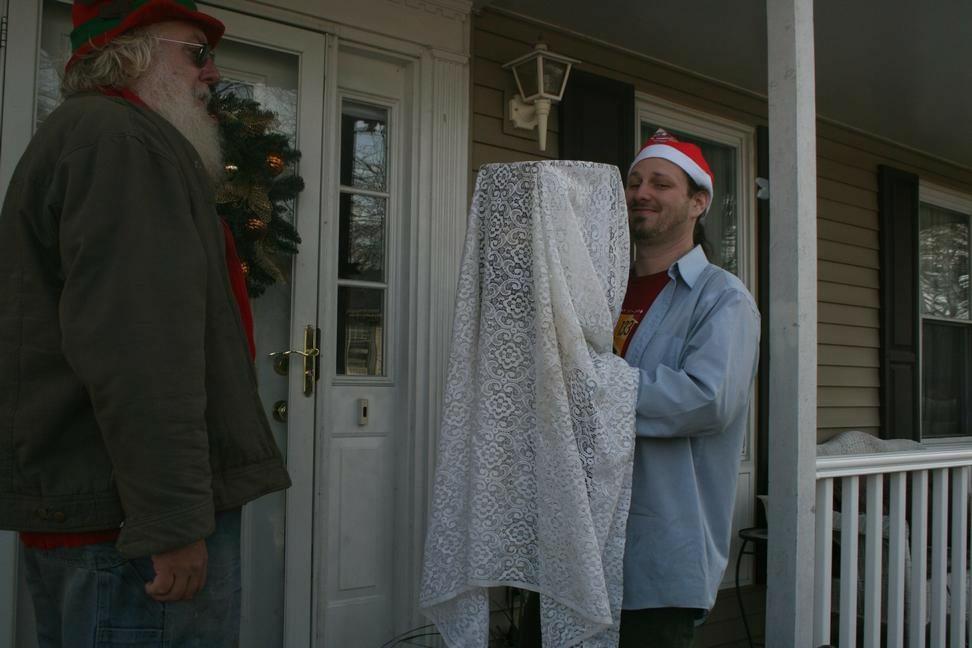 Exposing the box 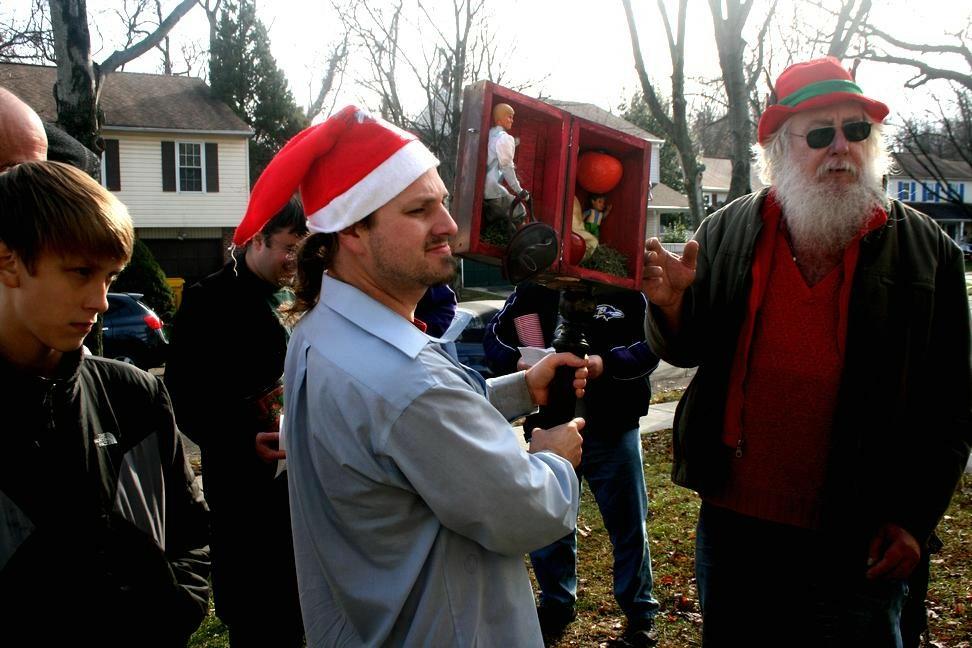 Receiving Donation  Wassailing mailman 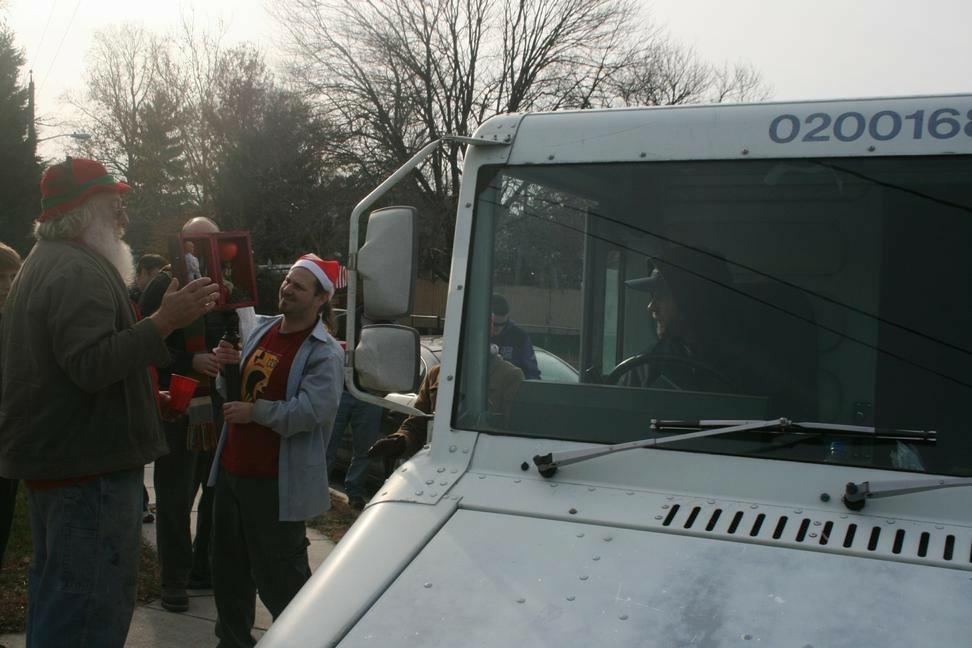 To return to the top click here |